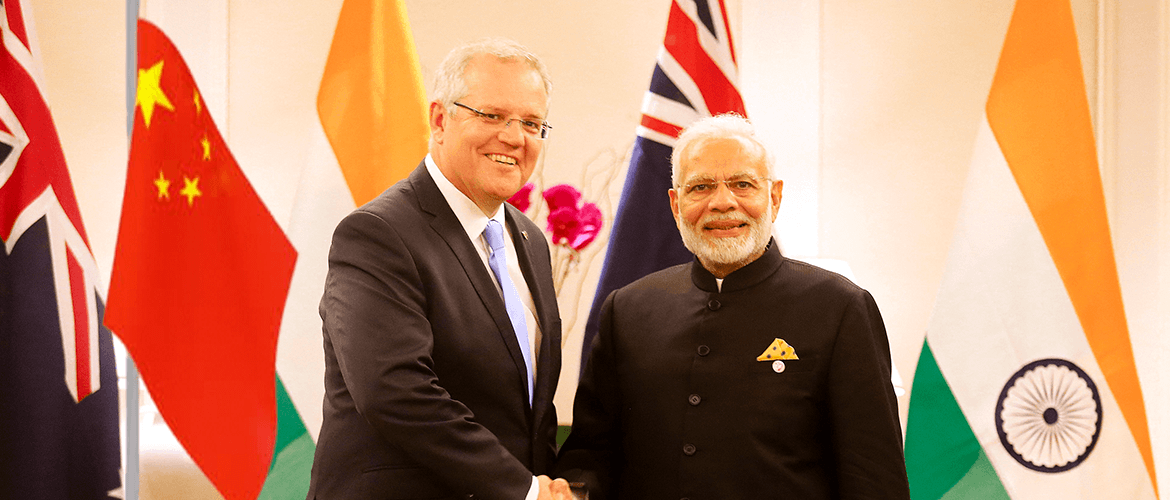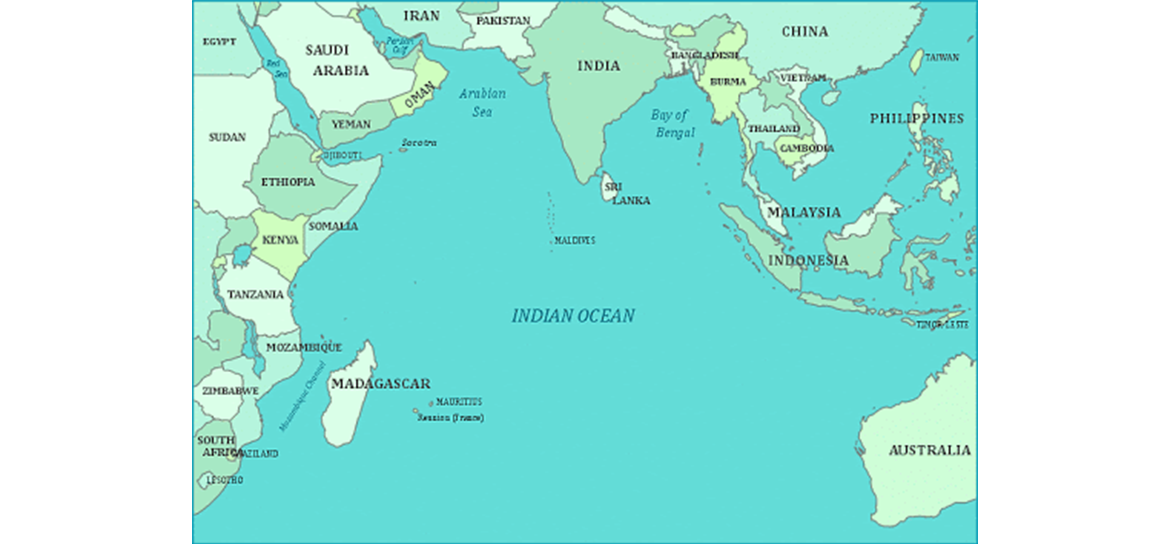India and Australia: In the Dragon's shadow
June 19, 2020 | Expert Insights

In a first of its kind, a virtual bilateral summit was held between Indian Prime Minister Narendra Modi and Australian Prime Minister Scott Morrison on June 4. This is being viewed as perhaps the beginning of a new strategic alliance in the Indo-Pacific region.
Amidst the host of agreements made during the summit -- on cyber technology, agribusiness, mining of strategic minerals, water management, among others -- were two significant agreements which could alter the scale and depth of their strategic relationship. Both leaders agreed to upgrade their relationship to a 'Comprehensive Strategic Partnership' with focus on 'maritime cooperation in the Indo Pacific'. Respective armed forces will now lease each others' "military spaces". Both are members of the Quad (Quadrilateral Security Dialogue) along with the U.S. and Japan, and the summit reiterated the value of this security alignment between the major naval powers of the Indo Pacific. It would be pertinent to mention that for some years now, the Australian navy had been staying away from the Quad Naval manoeuvres, allegedly on the behest of China.
A MUTUALLY BENEFICIAL RELATIONSHIP
India and Australia, while sharing a Commonwealth legacy, have had their share of bumps in relationship. It was a close ally of the U.S. during the cold war, while India pursued a path of non-alignment. However, Australia extended its support to India during the 1962 border clashes with China. When India tested its peaceful nuclear device in 1998, Australia was one of the strongest critics and imposed a slew of restrictions/embargoes.
The thaw in the relationship had its origin in 2014 when the Australian and Indian Prime Ministers announced a Framework for Security Cooperation, in response to the changing security dimensions with the rise in Chinese maritime power. The Australian Foreign Policy Blueprint of 2017 ranked India at the forefront of its international partnership due to its importance for the geostrategic stability of the Indian Ocean Region. As India’s strategic closeness with the U.S. has increased, Australia too has found greater congruence with its own national security objectives, especially in view of greater naval completion in the region now being called as the Indo Pacific.
This saw the tentative beginning of joint military exercises and engagements to include AUSTRAHIND (Special Forces), AUSINDEX (bilateral maritime), KAKADU (multilateral maritime) and PITCH BLACK (multilateral air). The newly signed Mutual Logistics Support Agreement (MLSA) is a significant step towards unrestricted access to each other's military facilities, a pre-requisite for large-scale interoperability.
On the economic front, a rising India saw greater opportunity to feed off Australia’s vast natural resources. In 2017, the Australian government commissioned an India Economic Strategy (IES) to encourage mutual trade in agribusiness and mining, to name a few. By 2018-19, India had emerged as Australia's eighth-largest trading partner and fifth-largest export market.
IMPLICATIONS OF THE 'COMPREHENSIVE STRATEGIC PARTNERSHIP'
It is hard to see the India-Australia summit in a light other than that of geopolitics, considering all that has gone down (and is going down) between Australia and China, and India and China. Official recognition by Australia to a rapidly escalating global demand for an inquiry into the cause and spread of COVID-19 in China has not gone down well with the People's Republic of China. China retaliated by raising tariffs on Australian exports of barley and meat, both of which are a major part of Australia’s export earnings. Australian government departments have also had to repeatedly step in to deter aggressive Chinese acquisition manoeuvres aimed at, amongst others, controlling interests in the strategic Darwin port, in the power distribution company Ausgrid, which also provides critical communications infrastructure and ownership of over 1,00,000 sq. km of prime land used by the cattle industry.
India is similarly placed, although its sharp differences over lingering territorial disputes and Chinese strategic support to its "all-weather ally Pakistan" makes its differences with China far more insurmountable.
The declaration at the highest level opens up new vistas for strategic cooperation. Australia should become a regular member of the annual Malabar series of Indian Naval exercises conducted in the India Ocean. The U.S. and Japan are regular participants. Very strong geostrategic messaging will emerge when four of the region’s most powerful navies come together to enhance interoperability.
The partnership has immense potential for mutual economic benefits. Australia is an attractive trading partner with a U.S.$ 1.4 trillion GDP and an abundance of natural resources which can meet India's expanding needs. Australia is an attractive destination for higher education, with excellent scientific and technological research institutions spread over peaceful campuses. With China’s economic sanctions increasing against Australia, India could be the friend it needs. Having managed the COVID better than most countries, Australia could open up sooner than other countries to chart a way back to normalcy.

Assessment
With multilateral institutions on the wane, India needs to strengthen its circle of bilateral friends. Australia provides a great opportunity to launch this move, which has been clearly indicated by the recently concluded virtual summit.
Despite the baggage of cold war and mutual suspicions, both countries have matured to recognise the changing equations in the global power play. Both advocate a "free, open, and inclusive Indo Pacific", with the rule-based world order. Both seek to advocate the freedom of navigation in international waters and that their convergence -- with their powerful navies behind them -- can stem the tide of expansionism in the region. The comprehensive strategic partnership would ensure peace in the region and encourage trade and well-being.
COVID-19 has created new challenges and opened new opportunities for countries to come together and seek mutually beneficial cooperation, not only in combating pandemics but also to safeguard their national interests. The scale of security challenges confronting both countries in the Indo Pacific demands major initiatives that go far beyond these initial incremental steps.








Comments